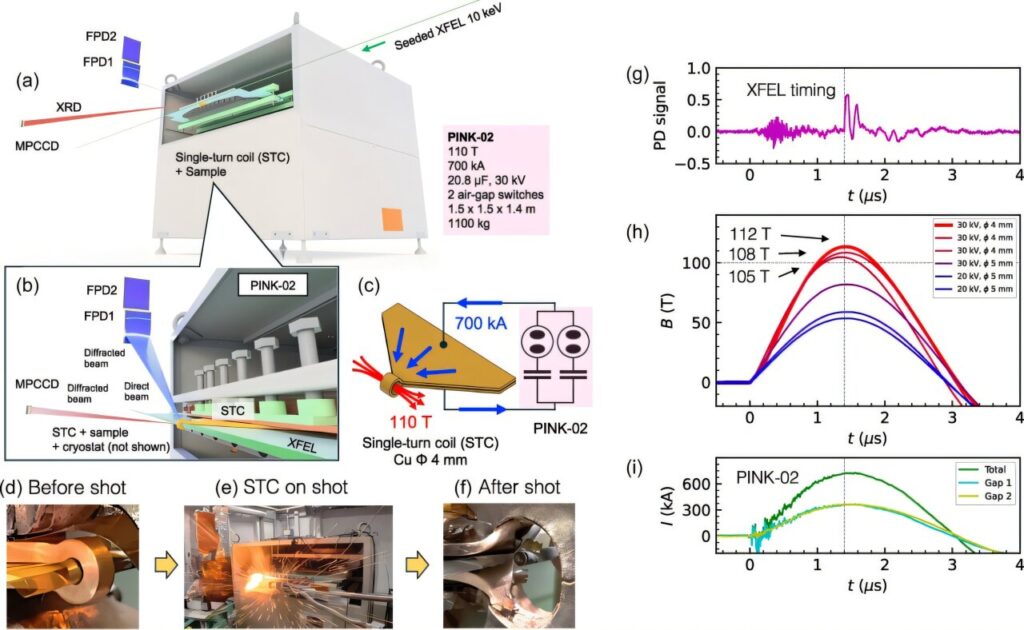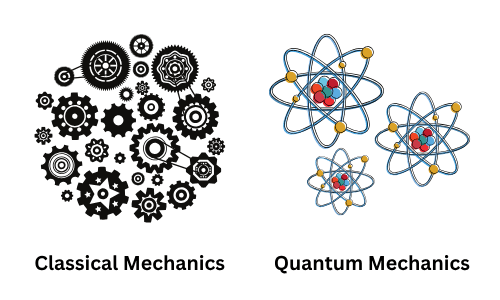When we think of magnets, we usually imagine the small, familiar ones on our refrigerator doors. Yet the magnetic fields created in cutting-edge physics experiments are so powerful that they push the limits of what matter itself can endure. Under magnetic fields stronger than 100 tesla—millions of times greater than Earth’s natural field—materials can behave in ways no one has ever seen. Electrons twist into new patterns, atoms rearrange their positions, and the very structure of matter begins to transform.
These extraordinary forces give rise to strange and fascinating phenomena. One of the most intriguing is magnetostriction, a process in which a material’s crystal lattice stretches, compresses, or distorts when exposed to intense magnetic fields. At these extreme scales, physics enters a new realm—one where the invisible dance of electrons reshapes the world of atoms.
Until recently, observing such transformations was nearly impossible. Generating magnetic fields beyond 100 tesla for more than a few millionths of a second is a technological and physical challenge. The coils that produce these fields can literally explode under the immense stress. But a pioneering team of researchers in Japan has achieved what once seemed unattainable: capturing real-time images of atomic structures under these extreme magnetic forces.
Pushing Technology Beyond Its Limits
Led by scientists at the University of Electro-Communications and RIKEN, the research group developed a groundbreaking device known as PINK-02—a portable generator capable of creating magnetic fields of around 110 tesla for just a few microseconds. Though fleeting, these bursts of magnetism are long enough to reveal how atoms react in the presence of such immense forces.
The researchers paired this generator with the world’s most advanced imaging technology: an X-ray free-electron laser (XFEL). XFELs produce incredibly short and powerful pulses of X-rays—bursts so fast that they can freeze atomic motion in time, capturing matter at the instant it changes.
With PINK-02 and the XFEL working in perfect synchronization, the team directed their attention toward a simple yet profound element—oxygen. In its solid form, oxygen becomes a crystal at extremely low temperatures. Under normal conditions, its atomic structure is well understood. But what happens when solid oxygen is placed inside a 110-tesla magnetic field?
The researchers’ goal was to find out.
Capturing a Moment of Transformation
Using the portable generator, the scientists subjected crystals of solid oxygen to an ultrahigh magnetic pulse lasting only a few microseconds. During that brief window, they fired XFEL laser pulses—each lasting a quadrillionth of a second—directly at the sample. These ultrafast X-rays produced snapshots that captured the precise positions of oxygen atoms at the moment the magnetic field peaked.

What they saw was astonishing. Under the influence of the intense magnetic force, the oxygen crystal stretched by about 1%—a colossal deformation at the atomic level. This massive magnetostriction meant that the magnetic field had physically altered the lattice of the crystal, stretching it in a way never before observed.
For the first time in history, scientists were able to see how atoms in a material shift under an ultrahigh magnetic field exceeding 100 tesla. The experiment did not just confirm theoretical predictions—it opened an entirely new window into how magnetism and matter interact under extreme conditions.
The Secret Life of Spins
At the heart of these dramatic transformations lies one of quantum physics’ most fundamental properties: the spin of electrons. Spin can be thought of as the tiny, intrinsic magnetism of each electron—a kind of built-in orientation that governs how electrons behave and interact. When placed in strong magnetic fields, these spins can realign themselves, influencing how atoms connect and how a material’s structure stabilizes.
In solid oxygen, the researchers found that this realignment of spins competes with the natural forces holding the lattice together. As the field strengthens, the balance shifts, and the entire crystal structure responds—stretching, bending, and reshaping itself. The gigantic magnetostriction observed was a direct result of these competing spin interactions.
This discovery has far-reaching implications. It shows that spins are not just passive participants in the structure of matter—they can actively control it under the right conditions. Understanding how this happens could lead to breakthroughs in material science, condensed matter physics, and even future technologies that harness magnetism in new ways.
Engineering the Impossible: The Power of PINK-02
Achieving such an experiment required more than clever theory—it demanded an engineering marvel. Traditional methods of producing strong magnetic fields involve huge, immovable facilities with coils that often self-destruct after each pulse. In contrast, the Japanese team’s PINK-02 generator is small, portable, and designed to work safely with delicate experimental setups.
By combining portability with the precision of XFEL technology, the researchers created a tool capable of exploring the uncharted frontier of ultrahigh magnetic fields. For physicist Akihiko Ikeda, the study’s first author, this breakthrough represents both a technological and scientific triumph. “We conducted an X-ray experiment above 100 tesla for the first time,” Ikeda explained. “It is significant in terms of exploring the frontier.”
The ability to synchronize such intense fields with femtosecond X-ray pulses allows scientists to “freeze” and observe atomic-scale transformations in real time—something once thought to be beyond reach.
Stretching the Boundaries of Condensed Matter Physics
The team’s work, published in Physical Review Letters, marks the beginning of a new era in condensed matter research. For decades, physicists have theorized that extreme magnetic environments could reveal hidden phases of matter—exotic states that exist only when electrons and spins behave in novel ways.
By proving that such environments can now be both generated and observed, the researchers have laid the groundwork for a deeper understanding of the quantum behavior of materials. Their results suggest that even common substances like oxygen can exhibit previously unknown properties under extreme conditions.
Ikeda and his team are already looking ahead. “We will now try to uncover the crystal structure of solid oxygen called the theta (θ) phase,” he said. “By further increasing the available magnetic fields up to 120 or 130 tesla, we will explore how crystal structures change in various materials above 100 tesla.”
These efforts could unlock entirely new forms of matter, with potential applications ranging from quantum computing to advanced superconductors.
Why This Discovery Matters
While the idea of stretching crystals with magnetism might sound abstract, the implications reach far into the technologies of the future. Understanding how materials behave under extreme conditions helps scientists design stronger, more efficient systems—whether in aerospace, nuclear energy, or electronics.
Moreover, the insights gained from studying atomic spins and lattice responses could inspire new materials that change their shape or properties in response to magnetic fields. Imagine sensors that deform to detect subtle changes in their environment, or adaptive materials that respond dynamically to external forces.
On a more fundamental level, this research reminds us how much remains hidden in the natural world. Even something as simple as oxygen—a gas we breathe every moment—holds mysteries that only reveal themselves under the most extreme conditions imaginable.
The Frontier of Magnetic Matter
In the silence of a laboratory in Japan, for just a few millionths of a second, atoms of oxygen experienced a force unlike anything in nature. They stretched, twisted, and revealed a secret that had been locked within their lattice for eons.
Through ingenuity, persistence, and the courage to push technology to its limits, scientists have captured that fleeting moment—turning microseconds into knowledge that will endure for decades.
The discovery does more than expand our understanding of magnetism. It shows that even in the smallest moments and the briefest flashes of light, the universe still holds endless wonders waiting to be seen.
With every pulse of the PINK-02 and every snapshot from the XFEL, humanity steps closer to understanding how matter bends, breathes, and transforms under the most extraordinary forces. It is, quite literally, the science of stretching the limits of reality.
More information: Akihiko Ikeda et al, X-Ray Free-Electron Laser Observation of Giant and Anisotropic Magnetostriction in β-O2 at 110 Tesla, Physical Review Letters (2025). DOI: 10.1103/r7br-qnrn.






